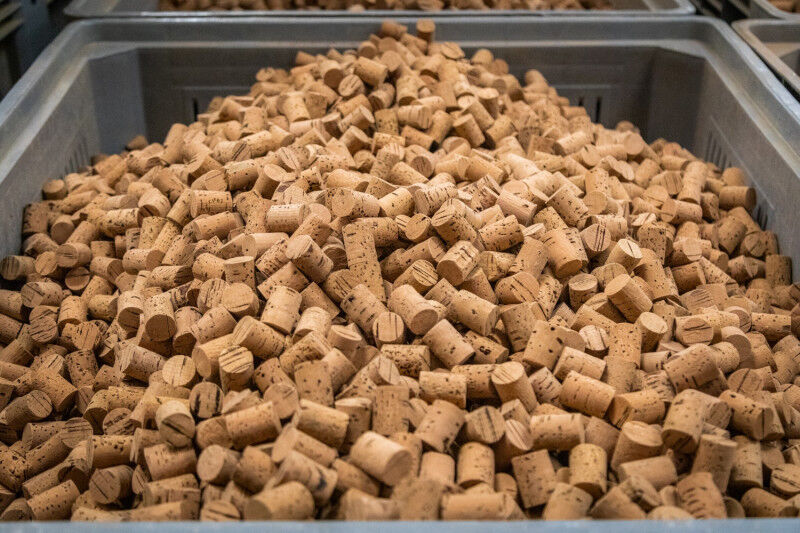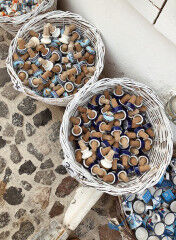Cork: a strategic material cork eco-friendly? We look at how environmentally friendly cork wine bottle stoppers are produced in Italy and how they impact wine production. The results will surprise you!
We will look in to the following:
- The production process
- The Cork Harvest & Seasoning
- Selection and Cutting of the Planks to make corks
- Top quality selections
- How much CO2 do cork trees absorb?
- What’s So Sustainable About Cork?
- Some numbers about Cork Product Industry in the Mediterranean
- Last but no least: Did you know Cork is not just for wine bottles?
The Cork Oak, officially the Quercus suber L., is an evergreen oak variety. These woods are formed spontaneously throughout a vast landscape, with its epicenter in the central-western points of the Mediterranean Basin. We find Italian Cork Oak pockets in a relatively restricted area that includes Sardinia, Sicily, Calabria, Lazio, and Tuscany.
The Production Process
The Cork Oak typically enjoys a long lifespan, even at times reaching up to multiple centuries. The tree can reach up to 20 meters in height, and generally has an attractive, twisted tree trunk with a bark that appears at first smooth and which later becomes deeply fissured and quite thick.
When the tree has reached 60cm in diameter, the first formation of the cork, called sugherone or male cork, is removed from the tree. Cultivators must wait before removing the second formation cork, called sughero gentile or sughero femmina. The wait time can be as long as 9-10 years, although before removing the first lot, harvesters must wait at least 3 decades.
The harvesting period generally lasts from May through the end of August, and is done when the tree is in its succhio phase, or when the bark is very easily detached from the tree trunk. Careful attention must always be paid to not damage the phellogen, a thin ring growing in the tree’s primary bark, and which allows to tree to continue the regeneration of its external panels.
One of the first wine-creators to use corks might come as a surprise: Dom Pérignon led the way. See how, Dom Pérignon's Real Life Contributions.
A typical Cork Oak can tollerate about 15 debarking passages throughout its lifetime. Anything above 15 usually exhausts a tree (although, even following this schedule, 15 debarking episodes brings us to 1.5-centuries of tree lifetime!).
The Cork Harvest & Seasoning
Participating in the cork harvest is an incredible, unique visual experience, as the trees appear completely shorn (not unlike sheep), with only the smooth, red trunk visible and showing the scars of its recent bark removal.
The Calangianus area of Sardinia’s Gallura region is a wonderful place to witness this process. Thanks to the support of Portugal’s APCOR (Portuguese Cork Association) and Italy’s ASSOIMBALLAGGI - Federlegno/Arredo, we can understand more about this magical process. Come visit Sardinia to experience the harvest, set in a backdrop of pure magic with the nearby granite boulders rising up amongst the trees like prehistoric works of art. Let me share what I learned here about cork and its harvesting.
While we’re talking about wines, what about women who work in this field? Read more about how women are changing the facets of a classically-male oriented world, Is Inclusivity the Real Deal for Women in the World of Wine?
Following their harvest direct from the trees, cork planks must be allowed to rest at least 6 months, in a sort of outdoor seasoning period. Following their rest period, the cork planks are then boiled to help make the material more elastic and flat.
Selection and Cutting of the Planks to make corks
Once again, the cork planks are subjected to an odor-based test, as some of the cork’s possible defects can be already identified at this stage. An expert with a specialized “nose” will sniff each plank as part of the testing process, and for the planks that pass the odor test, they will be cut into strips.
These strips are perforated laterally, giving the corks a natural cylindrical shape. During this process, the cork material will also form residual granules from the cork cutting process. These granules will be compressed together to prepare agglomerated corks.
The corks go through a further selection and shaping process, with defective corks being eliminated from the final selection of suitable corks. The final stages include a washing and branding process done with food-grade or fire-branded inks. Once the production process is complete following the inking passage, the corks are packed in plastic bags with SO2 (sulfur dioxide), a gas that protects the finished corks from microbial proliferation.
Top quality Sustainable Corks
At this stage, the corks are ready to go, although some top-quality producers do have a further step, once again relying on the acute sense of smell testers can develop. Primarily female, these sniff-testers are tasked with the responsibility of recognising internal cork defects, from the classic TCA smell (2,4,6-trichloroanisole, a chemical responsible for creating a musty aroma in wines), or a corky smell. The testers are also able to sniff out other unpleasant odors like mushroom or mold, preventing the corks from possibly damaging whatever element they’re meant to protect.
Another much beloved pairing with finely-preserved wines and their corks that play a fundamental role in wine maintenance is cheese. Italy’s got a world of selection, starting with artisanal producers like Andrea Magi. Learn more, Andrea Magi's Love of Cheese Knows No Bounds.
How much CO2 do cork trees absorb?
Cork forests are one of the few examples of totally sustainable forestry: for each ton of cork extracted, an amount of carbon equivalent to 73 tons of CO2 from the atmosphere can be captured in the forest.
The cork forests are one of the world’s 36 biodiversity hotspots, as they are the natural habitat of many flora and fauna species. In the context, studying the variables of productivity, the growth index of cork and the decortication interval becomes imperative. These are all elements of top-notch quality that are guaranteed by product labels like Corkmark and FSC®️.
Sustainability doesn’t just have to apply to materials - we can use sustainable when talking about food and a finished product ready to eat. See what we have in mind, Do Sustainable Panettones Exist? Yup, wanna know where?
What’s So Sustainable About Cork?
While every generation likes to attribute new innovations to itself, the use of cork actually does date back to the ancient Egyptians and Babylonians, foreshadowing us by just a few millenium. Ancient populations found cork to be useful in a variety of methods, from food and beverage storage to insulation materials (remnants of cork insulation have been found in several Sardinian nuraghi, the intriguing megalithic structures found dotting the Sardinian countryside), as well as a decorative function.
The cork Oak tree’s outer bark increases in volume much in the same way as the growth rings function in the inner tree trunks. The bark undergoes continuous regeneration thanks also to the hard work of bucadori. These specialized workers expertly assess the tree’s bark development, and are able to indicate precise incisions on the bark where planks can be detached from the trees without damaging the oak tree in any shape.
Thanks to the passage of personal experience and knowledge from generation to generation, the younger era of bucadori is ensured, and the future of this highly-specialized work is guaranteed for the foreseeable future.
One technique the bucadori use to assess the quality of the cork planks is visual evaluation, but perhaps the more specialized technique is via smell. The odor of the planks must be delicate and a bit lactic, recalling the scent of fig blades.
Bucadori work is the highest-paying work in the agricultural realm, providing the bucadori with highly-valued daily wages. As such, the profession of being a bucadori provides a fundamental part of the social fabric of these communities. From an environmental perspective, the work of bucadori in preserving the cork forests is also significant in the fight against the desertification of Mediterranean areas.
What goes nicely with a properly-stored bottle of wine? How about some carbs? Check out Italy’s vast selections of this particular element, Italy's Breadbasket: Focacce, Pizza, Piadine… A Bounty of Bread.
Some numbers about Cork Product Industry in the Mediterranean
Companies that make cork products in an ecological friendly way have a variety of benefits. They reduce the amount of energy put in the manufacturing process and ultimately reduce its impact on the environment. By supporting this compliant measure, companies gain goodwill and reputation with their customers. Furthermore, the products themselves last longer and give better experiences.
The bulk of the world’s 200,000 tons produced annually takes place in the western Mediterranean Basin, the lion’s share being produced in the cork forests of Portugal.
Italy produces an annual average of 6,000 tons, with 90% of the cork forests being located in the enchanting northern Sardinian area of Gallura, specifically between Tempio Pausania and Calangianus. And in Spain, the cork forests are located in the province of Huelva.
In this area, we can find 250 companies (of differing dimension, from industrial sizes to individual artisans ) that process up to 70% of all the cork used in the production of cork stoppers.
This industry is fundamental for the local economy, and employs approximately 6,000 people, including direct, seasonal and Here 250 companies (including industries and artisans) process about 70% of all the cork used for the production of stoppers. A very important sector for the economy of this region that employs about 6,000 people including direct and seasonal workers, as well as affiliated workers involved in transportation and logistics in local industry.
Last but no least: Did you know Cork is not just for wine bottles?
It’s natural to associate cork with wine stoppers, but the use of this material goes far beyond just a wine bottle. One unexpected place you’ll find cork used in the aerospace industry.
Its inherent characteristics, including light-weight and resistance to high temperatures have attracted the engineers of NASA, the American aerospace agency, as well as the European Space Agency. These two bodies have deemed cork the ideal material to incorporate as an important part of their spacecrafts.
Don't forget to register for Mamablip's weekly newsletter for updates on all the exciting newest Mamablip Blog articles, recipes and other wine news from Italy.



